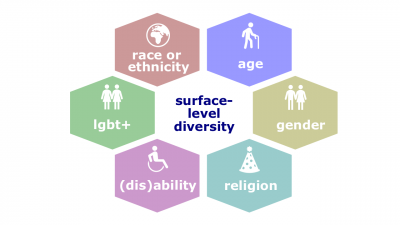Surface-level diversity
Surface-level diversity (hereinafter, the Diversity) is differences in easily perceived characteristics, such as gender, race, ethnicity, age, or disability, that do not necessarily reflect the ways people think or feel, but may activate or trigger certain stereotypes.
Definitions
According to Organizational Behavior by Robbins and Judge (17th edition),
- Surface-level diversity. Differences in easily perceived characteristics, such as gender, race, ethnicity, age, or disability, that do not necessarily reflect the ways people think or feel but may activate certain stereotypes.
According to Management by Robbins and Coulter (14th edition),
- Surface-level diversity. Easily perceived differences that may trigger certain stereotypes, but that do not necessarily reflect the ways people think or feel.
Related concepts
- Biographical characteristic. A quantifiable personal characteristic such as age, gender, income, education, socioeconomic status, family size, marital status, race, and length of tenure that are objective and easily obtained from personnel records. These characteristics are indicators of surface-level diversity.
- Race. The biological heritage (including skin color and associated traits) that people use to identify themselves.
